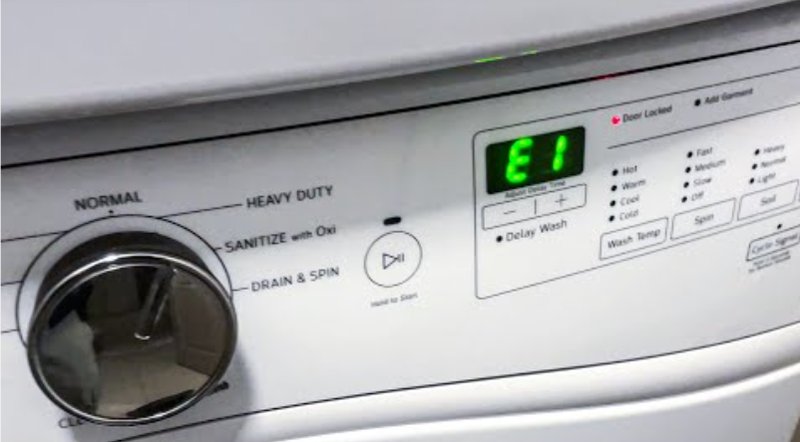
First things first, that E1 code is your dryer’s way of saying, “I need a bit of attention here!” It’s kind of like when your car’s check engine light comes on. Sure, it’s a little alarming at first, but it’s just a signal that something needs checking. Now, don’t worry; we’re here to decipher what your dryer’s trying to communicate. In simple terms, an E1 error in Whirlpool dryers usually points to an issue with the dryer’s temperature sensor. Picture the sensor as the thermostat in your house—it keeps things from getting too hot or too cold. If it’s not working right, your dryer might not be drying clothes efficiently, or it might be overheating. Either way, it’s a good idea to get it sorted.
Understanding the E1 Code
So, why exactly is your Whirlpool dryer flashing the E1 code? Let’s demystify this. The E1 error is typically associated with a problem in the dryer’s air flow or a malfunction in the thermistor, which is a small temperature sensor. Now, the thermistor’s job is pretty simple: it monitors the temperature inside the dryer to ensure your clothes are drying at the right heat level. If this little guy isn’t working properly, the dryer doesn’t know if it’s too hot or not warm enough, causing it to shut down or not dry effectively.
Think of the thermistor like your dryer’s inner weatherman. Just as you wouldn’t step outside without checking the temperature, your dryer relies on this component to know how to operate. When the thermistor sends an incorrect signal—or no signal at all—the dryer gets confused and throws up the E1 warning. This is your dryer’s “check weather app” moment.
But why does the E1 code pop up in the first place? A few reasons include lint buildup restricting airflow, a damaged or faulty thermistor, or even issues with the dryer’s control board. Imagine trying to drink through a straw clogged with paper; that’s how your dryer feels when lint chokes its airways. The good news? Solutions are often straightforward and manageable. Understanding these basics is the first step toward getting your dryer back on track.
How to Fix the E1 Error Code
Okay, so you’ve got an E1 error code staring you down. What next? Here’s the deal: you don’t need to be an appliance expert to handle this. Let’s go through a few practical steps that might help. Start with the simplest thing: check the lint filter. Remember, dryers and lint are like best friends, but too much of a good thing can cause trouble. Make sure the lint filter is clean, as a clogged filter can restrict airflow and trigger temperature issues.
If clearing the lint filter doesn’t solve the issue, we might need to dig a little deeper. The thermistor could be the culprit, and replacing it isn’t as intimidating as it sounds. It’s a small, inexpensive part located inside the dryer. If you’re comfortable with a bit of DIY, you can order a replacement thermistor online and switch it out yourself with the help of a few online tutorials. Still, if you’re not feeling confident about it, no shame in calling a professional. Sometimes a pro’s touch is the best way to put your mind at ease and ensure things are resolved correctly.
Occasionally, the problem might lie in the dryer’s electronic control board or wiring. Like the motherboard in your computer, the control board manages all the dryer’s functions. If it’s faulty, repairs can be more complex. In such cases, it might be more cost-effective to call a technician. They’ll have the right tools and knowledge to assess and address the issue thoroughly. Either way, rest easy knowing help is out there, whether it’s DIY or through a professional.
Preventing Future E1 Errors
No one wants to deal with recurring errors, right? The good news is, with a few preventive measures, you can help your dryer stay in tip-top shape and potentially avoid that pesky E1 code in the future. Start by making it a habit to clean the dryer’s lint filter before or after each load. It sounds simple, but it’s crucial for maintaining proper airflow and efficiency.
Next, consider giving the dryer’s vent system a thorough cleaning every few months. Just like your vacuum cleaner needs its filters cleaned to perform well, your dryer benefits from this too. This involves clearing any lint buildup from the vent hose and exhaust to prevent blockages. It’s a bit like clearing leaves from a gutter—tedious, but necessary to keep things running smoothly.
Finally, keep an eye on your dryer’s performance. If clothes aren’t drying as well as they used to, or if you notice any unusual noises or odors, don’t wait for the E1 code to show up. Addressing small issues early can save a lot of hassle down the road. Regular maintenance checks and an awareness of your dryer’s normal operation can keep it running smoothly for years to come. Remember, taking care of your appliances is much like nurturing a friendship—put in the effort, and you’ll have a reliable partner in your laundry routine.